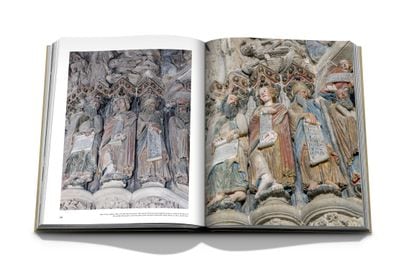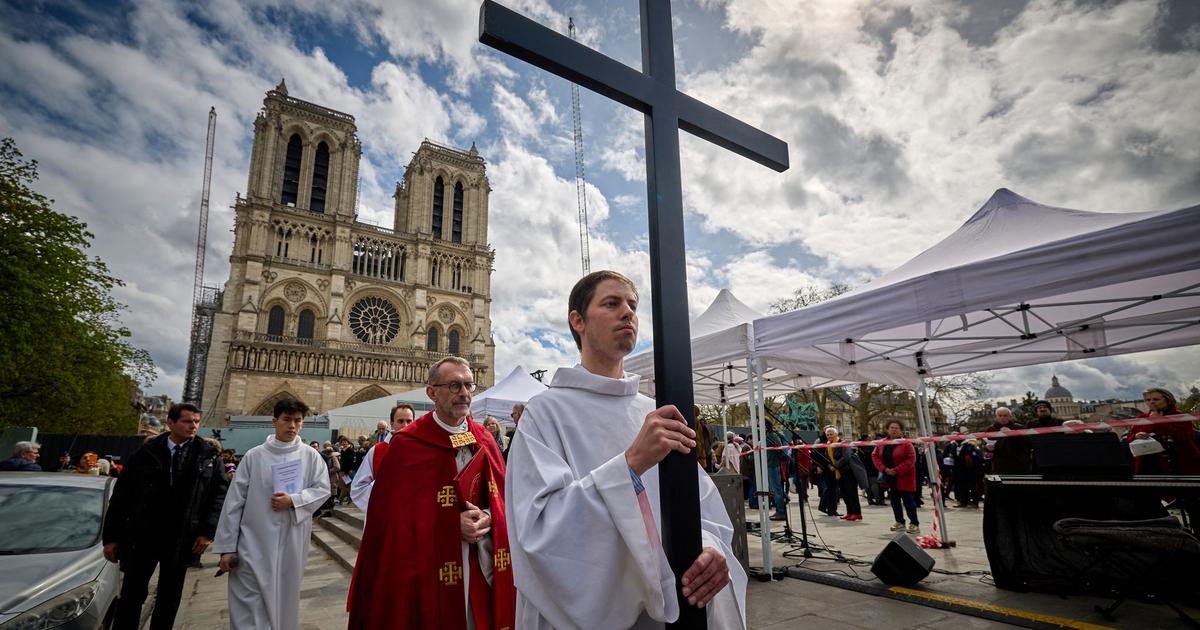You just have to climb the 155 steps that lead to the top of the Torre de la Carraca, in the Cathedral of Santiago, to look from there, to the northwest, Mount Pedroso: the place from which much of the granite that today he smiles or frowns, carved and painted in technicolor, in the Pórtico de la Gloria. On the slopes of Pedroso, one of the three abandoned quarries in the outskirts of Compostela that supplied Maestro Mateo's workshop is hidden among the brambles. It is still known by the older neighbors as “a canteira da cathedral”. But it was the analyzes carried out during the recovery process of this Romanesque masterpiece that confirmed its provenance. It was also known that the scarce marble used in various columns and pillars, as well as in the head of Saint Andrew,He was originally from Estremoz (Portugal) and O Incio (Lugo), where there is also a temple made of the same blue-hued material. The church of Hospital de Incio (12th century, like the Portico) was ordered to be built by the Order of Saint John of Jerusalem in a variant of the French Way to Santiago and is the only Romanesque built entirely in marble in Spain.
More information
The Pórtico de la Gloria, seen in an unpublished detail
The Portico recovers the colors of its glory eight centuries later
The Barrié Foundation, the entity that carried out, for 50,000 hours between 2006 and 2018, the restoration of the Pórtico de la Gloria, has just published the book in which it reviews through photos and texts this milestone in the conservation of art in the 80 specialists participated and it cost 6.2 million euros. The process by which the admired gray monument revealed a few secrets in addition to its colors, hidden under the dust caked by centuries and moisture, has been written in Spanish and English.
Pórtico de la Gloria: A restoration
sees the light in a luxury edition (195 euros, circulation of 1,000 copies) or more affordable (30 euros, 2,500 units) under the seal of the New York publisher Assouline, specialized in art, travel, fashion and gastronomy.
Detail of the Pórtico de la Gloria.ÓSCAR CORRAL
To contemplate the monument now, he defends the volume, it is necessary to "avoid starting from the paradigm of monochrome sculpture that since the Renaissance has dominated the canons." The Pórtico was, from its conception by Mathew, "a polychrome work"; and "as if we were before successive layers of an ancient city, we find ourselves before the original sculpture to which the remains of the first polychrome [12th century] are linked", and on these, a second (16th) and a third (17th ), plus some later tweaks. Gaël de Guichen, member of the scientific committee for restoration and advisor to ICCROM, an international center dedicated to the study of the preservation and restoration of cultural property, describes in the foreword that “the dark and thick layer of dust” that overshadowed all this “ It wasn't just physical; it was also of ignorance ”."We knew nothing about the degree of preservation of the polychrome, its quality, the succession of historical strata or the effect that the removal of the gray layer would have on the monument," admits the specialist after the success of the intervention. For him, if the Portico always "conveyed a sense of life" through its more than 200 figures, today, in addition, it does so "because of the vividness of its colors."
"The great originality" of this Romanesque work "resides in its organic character", defends the book. “Like few others in the history of art, and none in its field, everything in the Portico is motivated and related; in conversation". "Even the smallest detail belongs to the discourse and there seem to be no casual gestures, casual colors or casual choices," he concludes, in a scenography that narrates "the concert of the end of time", in which "all the figures of the Old and New Testaments, angels and Jesus Christ himself ”.
Even in the areas of this sculptural ensemble measuring 18 meters long by 11 meters high where apparently there was no longer a trace of the Romanesque pigmentation, the microscope detected particles that revealed the composition and arrangement of the colors of their origin.
Since its inauguration in 1188, this space that was part of the narthex of the disappeared Romanesque façade spent three centuries in the open.
Until the cathedral chapter decided to protect it with exterior doors and renovate it by commissioning the second polychrome.
Images before and after the intervention collected in the book 'Pórtico de la Gloria: Una restoration'. Assouline / F.
Barrié / F.
Santiago's cathedral
"Our Portico can no longer be the one on the opening day", warns the recently published work. "It is a complex portico in which remains of all the historical interventions are conserved with uneven presence". "Only the eyes of the imagination can get an idea of what the great masses of gold and lapis lazuli could have been" coming from the mines of Afghanistan when they received "the impact of the last rays of the setting Sun" from the esplanade that today occupies the square. of the Obradoiro. Over time, not even the Sun impacted the sculptures in the same way, since the original façade was replaced by its current Baroque envelope, and the appearance of the restored Portico is closer than any other to the appearance it would have when applied. the third polychrome. During the years of rehabilitation,not a single new brushstroke was added to what was preserved under the dirty patina with which it entered the 21st century.
Sculptures that are at the same time voussoirs
Those bright and slightly nuanced colors, which are still evident in the most sheltered parts of the eardrum, evoked the vision of the sky and the stars.
In the 16th and 17th century polychromies, the expensive and brilliant blue of lapis lazuli was replaced by azurite, an abundant element in the Iberian Peninsula, and instead of the pure gold sheets an alloy of silver and gold was used.
The carnations (hands, feet, faces) are the ones that have best reached the present because they were the ones that were repainted the most and because they include lead (a component of the white color) in the mix.
Since the time of Maestro Mateo, "the technique used at all times was oil, always with linseed oil", which has given an "amazing" result, says the Barrié Foundation, and has maintained its shine to the present day.
Vrins quarry, near Santiago, one of the three from which the granite was extracted to carve the Pórtico de la Gloria.ÓSCAR CORRAL
But in addition to sculpture and painting, the Pórtico de la Gloria is architecture. Its arches are part of a structure devised by Master Mateo to bridge the uneven terrain that begins in the crypt, located at the ground level of Obradoiro Square, and reaches the roof. The studies prior to the cleaning served to reveal the ailments and dangers that threatened the work of art, but also to confirm, for example, that the elders of the main arch are complete voussoirs, not ashlars with embedded figures. The “subtle weightlessness and naturalness” of the stone sculptures of the Portico, with their anatomy and tunics, did not depend only on “the skill of the sculptor”, the book defends that puts the finishing touch to the investigation, “but also on the wisdom of the architect ”, who achieved“ a balance that has lasted for centuries ”.
Discover the best stories of the summer in
V Magazine
.















